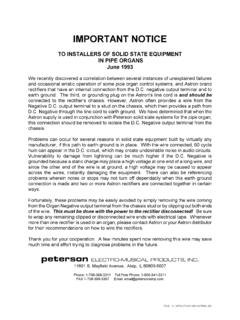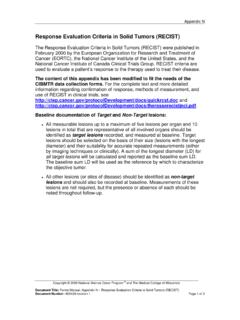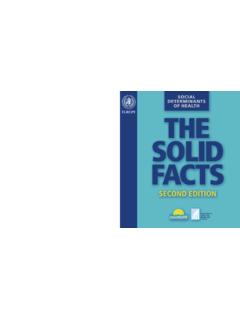Transcription of Low-Substituted Hydroxypropyl Cellulose NF
1 Low-Substituted Hydroxypropyl Cellulose NF. Functional Disintegrant CONTENTS PAGE 2. Introduction 3. Description 4. Manufacturing Process 6. Variety of grades 7. General properties 8. Interactions with water 9. Applications 11. Disintegration and Compressibility 12. Compatibility with active ingredients 13. Anti-capping 14. Direct compression 15. Wet Granulation (high speed mixer) 16. Wet Granulation (fluidized bed) 17. Pellet Extrusion 18. Formulation Examples 19. Bibliography 21. Product Specifications 22. INTRODUCTION 3. Introduction L-HPC ( Low-Substituted Hydroxypropyl Cellulose ) was first approved in 1977 as a disintegrant for pharmaceutical dosage forms in Japan. A recent survey shows that L-HPC is ranked as the first choice of tablet disintegrant by Japanese pharmaceutical companies. The key benefits of L-HPC include: Excellent compatibility with active ingredients Disintegration into smaller particles leading to better dissolution Anti-capping effect for tableting process.
2 Suitable for pellet extrusion as well as tableting. A variety of grades are available depending on application This brochure briefly describes the properties of L-HPC. If you are interested in its characteristics and application, or have any questions, please contact us for further information. DESCRIPTION 4. Trade name L-HPC. Generic name Low-Substituted Hydroxypropyl Cellulose Abbreviation L-HPC. IUPAC name Cellulose , 2- Hydroxypropyl ether (low substituted). CAS registry number 9004-64-2. Compendial status JP (Japanese Pharmacopeia). (As of August 2005) NF (US National Formulary). 21 CFR (Code of Federal Register / Food Additive). Structure DESCRIPTION 5. 4L-HPC vs. HPC. L-HPC is NOT the same as HPC. Although sharing the same CAS number, L-HPC has different characteristics from Hydroxypropylcellulose (HPC), a binding agent widely used for solid dosage forms. L-HPC and HPC have separate monographs in pharmacopeias. While the regular HPC has a large amount of hydroxypropoxy groups in the Cellulose backbone, L-HPC has only a small level (See the picture below).
3 Due to this chemical difference, HPC is soluble in water, but L-HPC is insoluble. HPC is typically used for granulation binder in an aqueous solution, but L-HPC cannot be used in this way. L-HPC is an effective disintegrant due to its swelling action in water, but this is not the case with HPC. Because L-HPC also has good compressibility, dry blending of this material produces hard tablets similar to those made from microcrystalline Cellulose . In this application, L-HPC functions as a dry binder.. MANUFACTURING 6. The raw material of L-HPC is highly- purified wood pulp. L-HPC is manufactured under GMP* (Good Manufacturing Practices). Our plant facilities have been inspected by more than 50 customers throughout the world. * Self-established excipient GMP based on the guideline proposed by IPEC. (International Pharmaceutical Excipient Committee). VARIETY OF GRADES 7. Currently six grades are commercially available. They have different particle sizes/shapes and chemical substitution levels.
4 The numbers have variations depending on lot, grade, and determination method. See the following table. The following data shows only typical and approximate values. These are not specifications. For specifications, see page 20 of this brochure. 4 Nomenclature GENERAL PROPERTIES 8. Appearance White to slightly yellow powder True density g/cm3 (measured with helium pycnometer). Solubility Not soluble in water or practical organic solvents. Swells in water. Soluble in 10 % NaOHaq., as a viscous and turbid solution. Thermal degradation approx. 260 C. temperature Equilibrium moisture content (25 C). Water- Soluble Substances INTERACTION WITH WATER 9. 4 Swelling property L-HPC is not soluble in water. However, it absorbs water and significantly expands in volume. This swelling action causes tablets to quickly disintegrate. The swelling volume is dependent on particle size and hydroxypropoxy content, as shown below. This experiment was carried out using an apparatus shown on the right.
5 For test formulation, disintegrant and alumina were blended 1: 4 to reduce the effect of strong binding between disintegrant particles. Compared to other excipients, L-HPC swells and reaches to its maximum volume quicker. INTERACTION WITH WATER 10. 4 Water Uptake 4 Effect of Test Fluid This data shows water uptake through a bed of Water uptake was tested using various test disintegrant powder using an apparatus shown fluids. L-HPC shows pH-independent below. Similar to the swelling property, the characteristics. In contrast, the behavior of water uptake level depends on particle size and ionic disintegrants was dependent on test hydroxypropoxy content. Compared to the fluids. other super-disintegrants, L-HPC absorbs a great amount of water and reaches a plateau in a short time. Test fluids: Purified water USP Simulated Gastric Fluid TS. (pepsin absent), pH USP Simulated Intestinal Fluid TS. (pancreatin absent), pH APPLICATIONS 11.
6 * If disintegration rate is not sufficient, try lower hydroxylpropoxy grades ( LH-22 and LH-32). Performances are improved in some cases. DISINTEGRATION AND COMPRESSIBILITY 12. Comparing disintegration capability of various disintegrants, the ranking is dependent on active ingredient and formulation. Looking at the data shown below, L-HPC has similar disintegration capability to the other super-disintegrants.. L-HPC also has a good compressibility compared to the other disintegrants. COMPATABILITY WITH ACTIVE INGREDIENTS 13. Because L-HPC is non-ionic, it is less reactive to active ingredients compared with ionic excipients. This excellent compatibility is the main reason for L-HPC being the first choice of Japanese pharma companies. For example, aspirin tablets with L-HPC were stable under high temperature whereas ionic ingredients showed whiskers of salicylic acid formed by hydrolysis (See picture below). Vitamin C tablets formulated with L-HPC showed no interaction compared with tablets using ionic disintegrants.
7 The color stability was even better than with microcrystalline Cellulose which is another non-ionic ingredient under the same moisture level. Our further study suggests that this was due to the low water activity of L-HPC because water molecules are bound to the amorphous region of the polymer. All tablets were made by direct compression. ANTI-CAPPING 14. One of the benefits of L-HPC is to resolve Anti-capping effect of L-HPC. capping, which is a typical problem in the (Ethenzamide tablets). tableting process. Several reports have pointed Tablets were prepared by direct compression. out that capping is caused by a high residual Excipients were added from 0 to 15 % in tablet. die-wall pressure during the tableting process. To measure capping number, 50 tablets were L-HPC reduces the residual die-wall force and tested using a USP friabilator. They were rotated ejection force during the tableting process. 750 times, and number of capped tablets was LH-11, the highly fibrous grade, is the most counted.
8 Effective for anti-capping, as entangling of fibers is important for capping prevention. Residual die-wall force and ejection force were measured using a tableting process analyzer (TabAll Model N30-EX, Okada Seiko, Japan). L-HPC content: 20 %. The above results are considered to be due to entangling of L-HPC fibers. Compared with microcrystalline Cellulose (MCC), fibrous structure can be seen in the cracking point of the L-HPC. tablet (See the pictures on the right). Such structure enables tablets to resist against damaging forces from all directions. DIRECT COMPRESSION 15. For direct compression, LH-21 is the primary grade to test. If you especially have a problem of capping, consider using of LH-11 (see page 14). If you need to use a large amount of L-HPC (more than 25. %), consider using LH-Bi (high density grade) for better flowability. Extreme case in direct compression (40% in the tablet). The performance of the existing products At higher speeds, LH-21 showed higher (LH-21) was the same or even better than variation of the tablet weights.
9 LH-B1 showed that of standard grade of MCC (Avicel lower variations similar to a high density grade PH1O1). of MCC (Avicel PH302). Formulation: Spray dried lactose L-HPC. Mg stearate 60 parts 40. Tableting: Laboratory scale rotary tableting machine (Vergo , Kikusui, Japan), 200 mg per tablet WET GRANULATION (HIGH SPEED MIXER) 16. In wet granulation, L-HPC gives a buffer effect stabilizing the wet- massing process for a wide range of water content. LH-21. is typically used for this purpose. Especially for active ingredients with poor solubility and low wettability, you can use a higher amount of L-HPC to improve disintegration. Even as much as 20 - 40 % of L-HPC has been used in a tablet for this purpose. In spite of such a high content, stability problems are not significant as seen in other ionic disintegrants. In such applications, tablets disintegrate in very fine individual particles, so the dissolution is rapid and complete.
10 WET GRANULATION (FLUIDIZED-BED) 17. In some cases a larger amount of L-HPC is needed to disintegrate and dissolve a poorly soluble drug. Because L-HPC is originally fibrous, the addition in a large amount may cause larger weight variation of tablets due to low flowability, or blocking of fluidization during the fluid-bed granulation. LH-B1, is designed to be non-fibrous and will be effective in such cases. Because this grade is not fibrous, there may be some limitation in compressibility. Formulation: Acetaminophen 40 parts Lactose 14. Cornstarch 6. L-HPC 40. Binder solution 60. (5%-HPC). Fluid-bed granulation: Multiplex MP-01 (batch size 200 g). Inlet 60 C. Outlet 30 - 35 t Spray rate 10 g/min Tableting: Laboratory scale rotary tableting machine (Vergo Kikusui, Japan), 200 mg per tablet Pressure: 1 t (198 MPa). Speed: 40 rpm PELLET EXTRUSION 18. As well as tableting, L-HPC is also applicable for pellet extrusion. Micronized grades (typically LH-31) are best suited for this application because smaller particles can easily pass through the screen.






